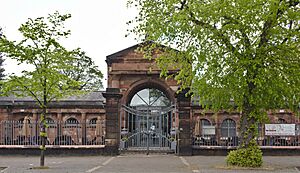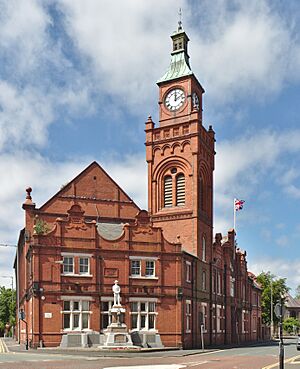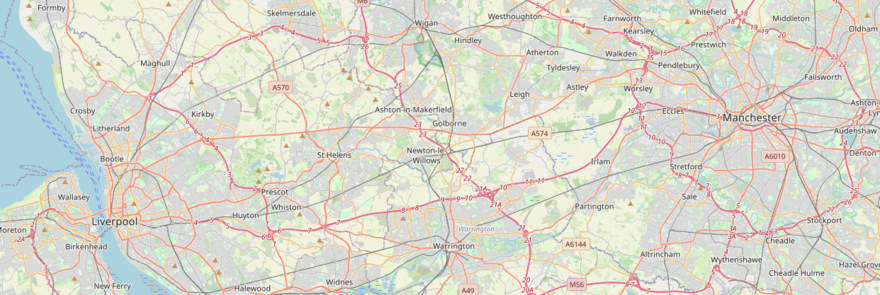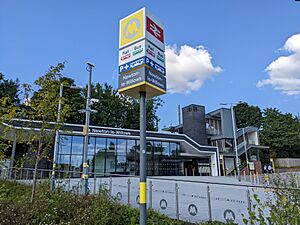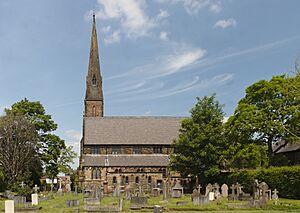Newton-le-Willows facts for kids
Quick facts for kids Newton-le-Willows |
|
|---|---|
| Town | |
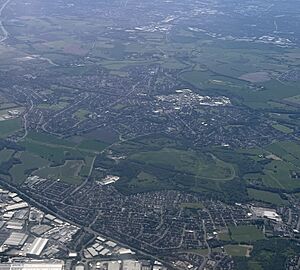 Aerial view of Newton-le-Willows looking south with Haydock in the foreground and Warrington in the background |
|
| Population | 24,642 (2021 Census) |
| OS grid reference | SJ580949 |
| • London | 171 mi (275 km) SE |
| Metropolitan borough |
|
| Metropolitan county | |
| Region | |
| Country | England |
| Sovereign state | United Kingdom |
| Post town | NEWTON-LE-WILLOWS |
| Postcode district | WA12 |
| Dialling code | 01925 |
| Police | Merseyside |
| Fire | Merseyside |
| Ambulance | North West |
| EU Parliament | North West England |
| UK Parliament |
|
Newton-le-Willows is a busy market town in Merseyside, England. It's part of the Metropolitan Borough of St Helens. In 2021, about 24,642 people lived here. Newton-le-Willows is on the eastern side of St Helens. It's located between Wigan to the north and Warrington to the south. It's also about the same distance from both Liverpool and Manchester.
Long ago, this area was mostly farmland. Over time, mining started to grow from the north and west. The town has been known since at least the 1100s. In the early 1800s, the town grew a lot. This happened because of the building of the Liverpool and Manchester Railway. The Sankey Canal also runs through the area. This meant the famous Sankey Viaduct had to be built by George Stephenson. The town of Earlestown grew up around the industrial work there. Earlestown slowly became the main center for the area.
Contents
What's in a Name?
Newton has had a couple of names over time. It was called "Newton-le-Willows" and "Newton in Makerfield." These names helped tell it apart from other towns called Newton. The name "Newton" simply means "new town."
"Makerfield" is a very old name for the area. It comes from an old British word "mager," which means "wall." This was combined with the English word "field." "Neweton" was first written down in the Domesday Book. The spelling of Makerfield changed over time. It was written as Makeresfeld in 1205 and 1351. By 1242, it was spelled Makerfield.
A Glimpse into History
Before the Norman Conquest in 1066, Newton was an important place. It was the head of a "hundred," which was a way to divide land. The king, Edward the Confessor, owned the manor of Newton. Later, the Newton Hundred joined with others to form the West Derby Hundred.
The fields between Newton and Winwick were the site of a big battle. This was the battle of Winwick, the last fight of the Second English Civil War.
Newton has two important railway stations. Newton-le-Willows railway station and Earlestown railway station both opened in 1830. They are some of the oldest railway stations in the world! Earlestown became a key railway junction. The first Liverpool and Manchester Railway line met a new line going south to Birmingham here in 1837.
The town also had three other railway stations. These were at Parkside, Vulcan Village, and the old racecourse. Parkside is famous for a sad reason. It was the site of the world's first fatal train accident. A well-known politician, William Huskisson, died there. Two other local railway landmarks are Newton Viaduct and the Sankey Viaduct. People often call the Sankey Viaduct the "Nine Arches" because of its design.
How the Town is Run
Newton-le-Willows has been part of Lancashire for a very long time. It was an ancient town. For many years, from 1558 to 1832, it was a "parliamentary borough." This meant it could send representatives to Parliament.
Later, as the town grew with industries, it became an "urban district." This was called Newton in Makerfield. In 1939, its name changed to Newton-le-Willows. On April 1, 1974, Newton-le-Willows joined with other local areas. They formed the St Helens Metropolitan Borough Council. This is part of the new county of Merseyside.
Today, Newton-le-Willows is divided into two areas for local government: Newton East and Newton West. Each area chooses three councillors to work on the St Helens Borough Council.
Where is Newton-le-Willows?
Newton-le-Willows is in the north-west of England. It's located just off the A580 East Lancashire Road. This road connects Liverpool and Manchester. The town is in the east of the Metropolitan Borough of St Helens in Merseyside. It's also very close to the border with Wigan in Greater Manchester. To the south, you'll find the Borough of Warrington in Cheshire. The larger built-up area of Newton-le-Willows includes Earlestown and parts of Wargrave and Vulcan Village.
 |
Skelmersdale, Haydock | Wigan, Ashton-in-Makerfield | Golborne |  |
| St Helens, | Lowton, Leigh | |||
| Burtonwood | Winwick, Warrington | Kenyon, Chat Moss |
Getting Around
The M6 and M62 motorways are very close to Newton-le-Willows. The A580 East Lancashire Road also passes nearby. These major roads have helped Newton become a popular place for people who travel to work. Many new homes have been built around the town's edges. You can reach the city centers of Manchester and Liverpool by train very quickly, in about 16 to 18 minutes.
The Sankey Canal goes through the town. The famous Sankey Viaduct crosses this canal. This viaduct carries the world's first passenger railway line.
Newton-le-Willows and Earlestown stations offer regular train services. You can travel to Liverpool, Manchester, St Helens, Warrington, Chester, and even along the North Wales coast to Llandudno. Earlestown is a large station for the size of the town, with five platforms. On platform 2, there's an old waiting room. It's thought to be one of the oldest railway buildings still standing!
There's also a small bus station in Tamworth Street. Buses run around the town and connect to nearby places. These include Burtonwood, Haydock, Ashton-in-Makerfield, Lowton, Garswood, and larger towns like Warrington, St. Helens, Wigan, and Leigh.
Places of Worship
Newton-le-Willows was once part of the ancient parish of Winwick. Today, the town has four Anglican parishes. These are St Peter's (for Newton), St John's (for Earlestown), Emmanuel (for Wargrave), and All Saints' (for the northern parts of town).
Like many towns in Lancashire, Newton has a large Roman Catholic community. There are three Catholic churches in the town: St Patrick's in Earlestown, St Mary and St John's in Newton, and St David's in Wargrave.
Other Christian groups also have churches in the town. These include Methodist and Baptist churches in the town center.
Local News and Radio
For many years, Newton-le-Willows had its own local newspapers. The Newton and Golborne Guardian was the oldest. It stopped being published in 2007. Other papers that served the town included the Earlestown Guardian and Newton Reporter. Today, the town gets free newspapers like the St Helens Star and St Helens Reporter. Larger newspapers like the Warrington Guardian, Liverpool Echo, Manchester Evening News, and Wigan Post are also available.
For local radio, you can listen to WA12Radio. This is an internet radio station that started in 2011. It's named after the local postcode, WA12. This station is now part of the Newton Boys and Girls Club. Regional radio stations include Heart North West, BBC Radio Merseyside, and BBC Radio Manchester.
The town is also covered by BBC North West and Granada for TV.
Sports in Town

The old Newton-le-Willows racecourse closed in 1898. It was replaced by Haydock Park Racecourse. The Old Newton Cup is a very old horse racing trophy. It has been competed for over 200 years!
Football has always been a big sport here. Newton-le-Willows F.C. had its own team from 1894 to 1908. They played in local leagues and later in the English Combination. Earlestown Football Club also had successful periods. They played in the Lancashire Combination league, which was a high level of football in the 1950s and 60s. Earlestown even signed famous player-manager Wilf Mannion. They played against teams like Wigan Athletic and Everton. Earlestown F.C. even played in the first-ever match at Anfield stadium!
Rugby league is very popular in the area. Teams like St Helens R.F.C., Warrington Wolves, and Wigan Warriors are all nearby. Newton-le-Willows didn't have its own rugby league team until 2002. That's when Newton Storm RLFC was formed. Storm has grown very quickly and is now one of the fastest-growing amateur rugby league clubs in the North West.
Rugby union was once the most popular type of rugby in town. Newton-le-Willows RUFC and Vulcan RUFC were strong teams. Famous players like Fran Cotton and Steve Hampson played for local teams.
Cricket is now the main sport in Newton-le-Willows. Newton C.C. plays in the top division of the Liverpool and District Cricket Competition. This is a major league in the North West. Vulcan C.C. also represents the town. Newton has produced several players who have gone on to play for Lancashire County Cricket Club.
Famous Faces from Newton-le-Willows
Many interesting people have connections to Newton-le-Willows:
- Rick Astley: A famous pop star, known for his hit song "Never Gonna Give You Up."
- Andy Burnham: He was a Member of Parliament and a government minister. He is now the Mayor of Greater Manchester.
- Ed Clancy: An Olympic Gold Medalist in cycling for Great Britain in 2008.
- Fran Cotton: A former rugby union player for England and the British Lions. He started playing for Newton RUFC.
- Joe Fagan: A former football player for Manchester City and a successful manager for Liverpool F.C..
- Norman Harvey: He was awarded the Victoria Cross for his bravery during World War I.
- Roger Hunt: A former Liverpool and England footballer who won the World Cup. His family's business is based in Newton-le-Willows.
- Martin Kelly: A professional footballer who played for West Brom and England U-21.
- Lynda La Plante: A well-known author, screenwriter, and former actress.
- Wilf Mannion: A famous former footballer who managed Earlestown F.C.
- Steve Marsh: An actor, known for playing Big Cook Ben in the TV show Big Cook Little Cook.
- Rodney Porter: A scientist who won a Nobel Prize in 1972.
- John Randall: A scientist who helped develop the cavity magnetron, used in radar systems.
- Colin Welland: A writer and actor who won an Oscar for writing the film Chariots of Fire.
See also
 In Spanish: Newton-le-Willows para niños
In Spanish: Newton-le-Willows para niños



